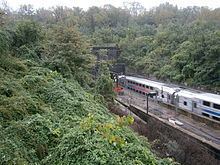Constructed 1904-1908 | ||
 | ||
End Pennsylvania Station in Manhattan, New York City | ||
The North River Tunnels are a pair of tunnels that carry Amtrak and New Jersey Transit rail lines under the Hudson River between Weehawken, New Jersey and Pennsylvania Station in Manhattan, New York City. Built between 1904 and 1908 by the Pennsylvania Railroad (PRR) to allow its trains to reach Manhattan, they opened for passenger service in late 1910.
Contents
Design and construction
Led by Chief Engineer Charles M. Jacobs, the tunnel design team began work in 1902. After plans were complete in 1904, the first task was digging two shafts, one just east of 11th Avenue in Manhattan and a larger one a few hundred yards west of the river. The Weehawken Shaft was completed in September 1904 as a concrete-walled rectangular pit, 56 by 116 ft (17.1 by 35.4 m) at the bottom and 76 ft (23.2 m) deep.
When the shafts were complete, O'Rourke Engineering Construction Company began work on the tunnels proper. The project was divided into three parts, each managed by a resident engineer: The "Terminal Station" in Manhattan; the "River Tunnels", east from the Weehawken Shaft and under the Hudson River; and the Bergen Hill tunnels, west from the Weehawken Shaft to the tunnel portals on the west side of the Palisades. (At the time, "North River Tunnels" referred to the tunnels east of the Weehawken Shaft; in later years the term has come to include the Bergen Hill tunnels as well.)
The tunnels were built with drilling and blasting techniques and tunnelling shields, digging west from Manhattan, east and west from Weehawken, and east from the Bergen portals.
Under the river itself, the tunnels started in rock, using drill and blast, but the strata under the river was pure mud for a considerable depth, so this part was driven under compressed air, using a Greathead shield, and lined with cast-iron segments bolted together. The mud was such that the shield was shoved blind, i.e. taking in no ground at all. But it was found easier to steer if some mud was taken in through holes at the front. The mud was the consistency of toothpaste.
The two ends of the northern tube under the river met in September 1906; at that time it was the longest underwater tunnel in the world.
Meanwhile, the John Shields Construction Company had begun in 1905 to bore through Bergen Hill, the lower Hudson Palisades; William Bradley took over in 1906 and the tunnels to the Hackensack Meadows were completed in April 1908.
The west portals are in North Bergen, at the west edge of the New Jersey Palisades near the east end of Route 3 at U.S. Route 1/9 (40.7714°N 74.0419°W / 40.7714; -74.0419). They run beneath North Bergen, Union City, and Weehawken, to the east portals at the east edge of 10th Avenue at 32nd St in Manhattan. (Since 1968 the east portals have been hidden beneath 450 West 33rd Street on the east side of 10th Ave.) When the top of the Weehawken Shaft was covered is a mystery; the two tracks may have remained open to the sky until catenary was added circa 1932.
Except for a curve west of the west end of Pier 72 that totals just under a degree, the two tracks are straight (in plan view); they are 37 feet (11.3 m) apart from west of 11th Avenue to the Bergen Hill portals. The third rail now ends just west of the Bergen Hill portals.
Operation and useful life
Since 2003, the tunnels have operated near capacity during peak hours. Trains ordinarily travel west (to New Jersey) through the north tube and east (to Manhattan) through the south. During the busiest hour of morning rush, about 24 trains are scheduled through the south tube, and the same through the north tube in the afternoon.
In June 2009, the Access to the Region's Core project began building a set of parallel tunnels to supplement the North River Tunnels, but that project was canceled in October 2010 by New Jersey Governor Chris Christie, who cited budgets constraints. On February 7, 2011, Amtrak announced that it would spend $50 million on preliminary engineering and design work for a new tunnel project called the Gateway Project, estimated to cost $13.5 billion.
The unprecedented storm surge from Hurricane Sandy flooded one of the North River Tunnels for the first time, damaging overhead wires, electrical systems, concrete bench walls, and drainage systems.
In May 2014, Amtrak CEO Joseph Boardman told the Regional Plan Association that less than 20 years remained before one or both of the tunnels would have to be shut down.
